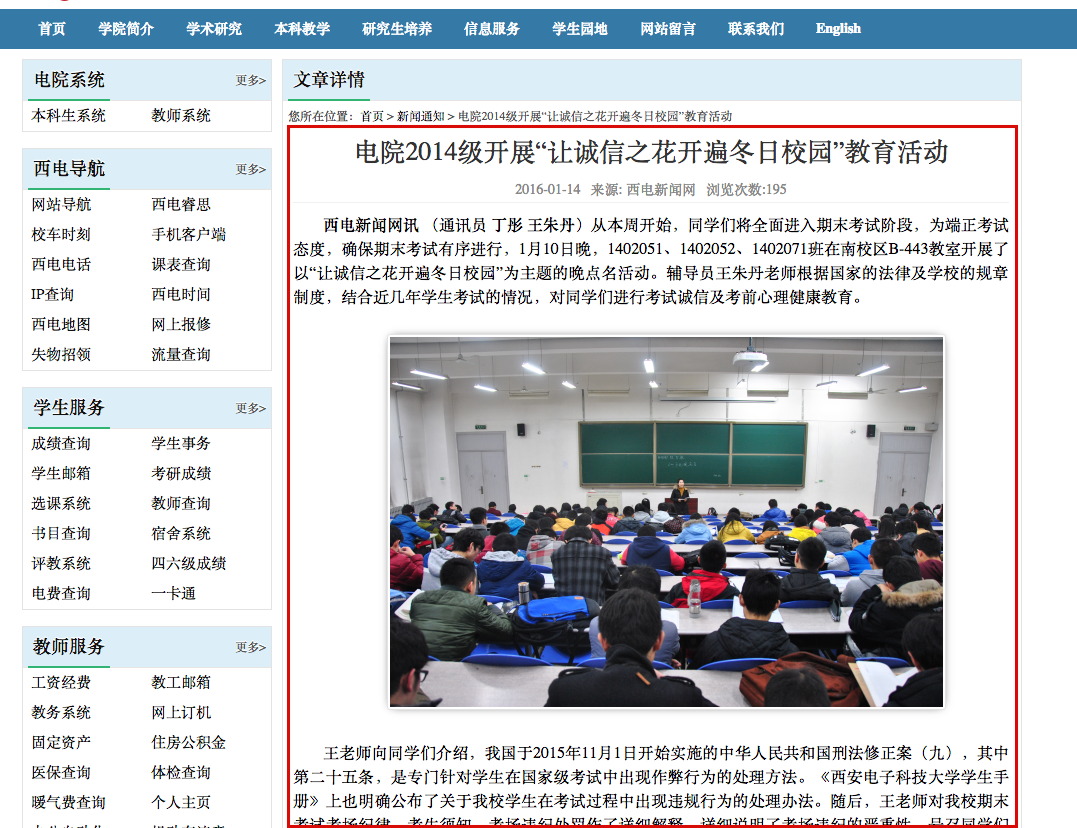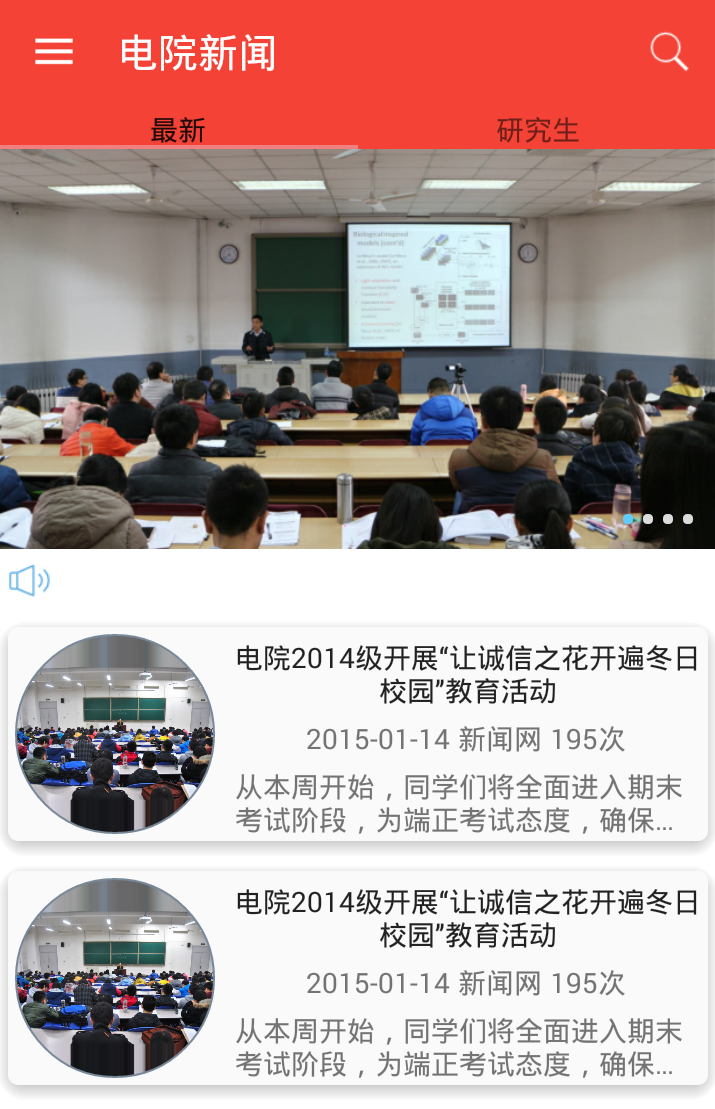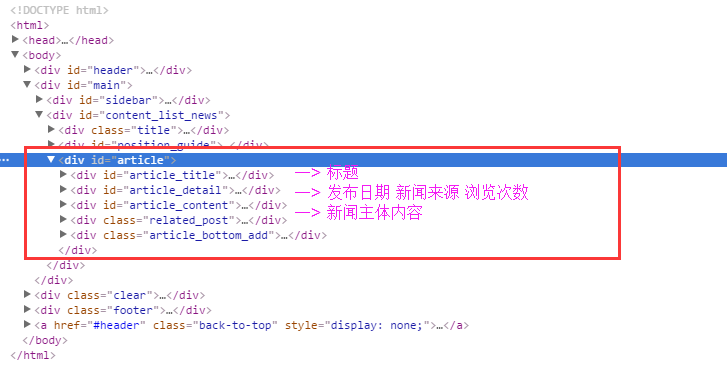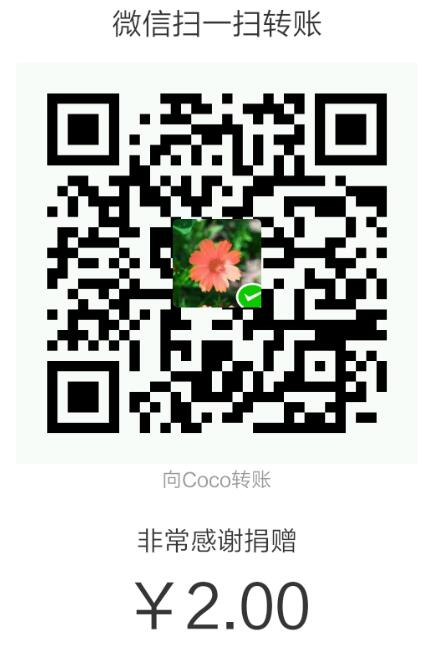Java實現爬蟲給App提供資料(Jsoup 網路爬蟲)
需求 ##
最近基於 Material Design 重構了自己的新聞 App,資料來源是個問題。
有前人分析了知乎日報、鳳凰新聞等 API,根據相應的 URL 可以獲取新聞的 JSON 資料。為了鍛鍊寫程式碼能力,筆者打算爬蟲新聞頁面,自己獲取資料構建 API。
效果圖
下圖是原網站的頁面
爬蟲獲取了資料,展示到 APP 手機端
爬蟲思路
關於 App 的實現過程可以參看這幾篇文章,本文主要講解一下如何爬蟲資料。
Jsoup 簡介
Jsoup 是一個 Java 的開源HTML解析器,可直接解析某個URL地址、HTML文字內容。
Jsoup主要有以下功能:
- 從一個URL,檔案或字串中解析HTML;
- 使用DOM或CSS選擇器來查詢、取出資料;
- 對HTML元素、屬性、文字進行操作;
- 清除不受信任的HTML (來防止XSS攻擊)
爬蟲過程
Get 請求獲取網頁 HTML
新聞網頁Html的DOM樹如下所示:
下面這段程式碼根據指定的 url,用程式碼獲取get 請求返回的 html 原始碼。
public static String doGet(String urlStr) throws CommonException {
URL url;
String html = "";
try {
url = new URL(urlStr);
HttpURLConnection connection = (HttpURLConnection) url.openConnection();
connection.setRequestMethod("GET");
connection.setConnectTimeout(5000 InputStream in = connection.getInputStream();將得到輸入流轉化為字串是個普遍需求,我們將其抽象出來,寫一個工具方法。
public class StreamTool {
public static String inToStringByByte(InputStream in) throws Exception {
ByteArrayOutputStream outStr = new ByteArrayOutputStream();
byte[] buffer = new byte[1024];
int len = 0;
StringBuilder content = new StringBuilder();
while ((len = in.read(buffer)) != -1) {
content.append(new String(buffer, 0, len, "UTF-8"));
}
outStr.close();
return content.toString();
}
}
解析 HTML 獲取標題
利用 google 瀏覽器的審查元素,找出新聞標題對於的html 程式碼:
<div id="article_title">
<h1>
<a href="http://see.xidian.edu.cn/html/news/7428.html">
關於舉辦《經典音樂作品欣賞與人文審美》講座的通知
</a>
</h1>
</div>我們需要從上面的 HTML 中找出id="article_title"的部分,使用 getElementById(String id) 方法
String htmlStr = HttpTool.doGet(urlStr);
// 將獲取的網頁 HTML 原始碼轉化為 Document
Document doc = Jsoup.parse(htmlStr);
Element articleEle = doc.getElementById("article");
// 標題
Element titleEle = articleEle.getElementById("article_title");
String titleStr = titleEle.text();獲取釋出日期、資訊來源
同樣找出對於的 HTML 程式碼
<html>
<head></head>
<body>
<div id="article_detail">
<span> 2015-05-28 </span>
<span> 來源: </span>
<span> 瀏覽次數: <script language="JavaScript" src="http://see.xidian.edu.cn/index.php/news/click/id/7428"></script> 477 </span>
</div>
</body>
</html>思路也和上面類似,使用 getElementById(String id) 方法找出id="article_detail"為Element,再利用getElementsByTag獲取span 部分。因為一共有3個<span> ... </span>,所以返回的是Elements而不是Element。
// article_detail包括了 2016-01-15 來源: 瀏覽次數:177
Element detailEle = articleEle.getElementById("article_detail");
Elements details = detailEle.getElementsByTag("span");
// 釋出時間
String dateStr = details.get(0).text();
// 新聞來源
String sourceStr = details.get(1).text();
解析瀏覽次數
如果打印出上面的details.get(2).text(),只會得到
瀏覽次數:沒有瀏覽次數?為什麼呢?
因為瀏覽次數是JavaScript 渲染出來的, Jsoup爬蟲可能僅僅提取HTML內容,得不到動態渲染出的資料。
解決方法有兩種
所以分析JS請求,找到對應資料的請求url
如果你訪問上面的 urlhttp://see.xidian.edu.cn/index.php/news/click/id/7428,會得到下面的結果
document.write(478)這個478就是我們需要的瀏覽次數,我們對上面的url做get 請求,得到返回的字串,利用正則找出其中的數字。
// 訪問這個新聞頁面,瀏覽次數會+1,次數是 JS 渲染的
String jsStr = HttpTool.doGet(COUNT_BASE_URL + currentPage);
int readTimes = Integer.parseInt(jsStr.replaceAll("\\D+", ""));
// 或者使用下面這個正則方法
// String readTimesStr = jsStr.replaceAll("[^0-9]", "");
解析新聞內容
筆者本來是獲取新聞內容純文字的形式,但後來發現 Android 端也可以顯示 CSS 格式,所以後來內容保留了 HTML 格式。
Element contentEle = articleEle.getElementById("article_content");
// 新聞主體內容
String contentStr = contentEle.toString();
// 如果用 text()方法,新聞主體內容的 html 標籤會丟失
// 為了在 Android 上用 WebView 顯示 html,用toString()
// String contentStr = contentEle.text();解析圖片 Url
注意一個網頁上大大小小的圖片很多,為了只獲取新聞正文中的內容,我們最好首先定位到新聞內容的Element,然後再利用getElementsByTag(“img”)篩選出圖片。
Element contentEle = articleEle.getElementById("article_content");
// 新聞主體內容
String contentStr = contentEle.toString();
// 如果用 text()方法,新聞主體內容的 html 標籤會丟失
// 為了在 Android 上用 WebView 顯示 html,用toString()
// String contentStr = contentEle.text();
Elements images = contentEle.getElementsByTag("img");
String[] imageUrls = new String[images.size()];
for (int i = 0; i < imageUrls.length; i++) {
imageUrls[i] = images.get(i).attr("src");
}新聞實體類 JavaBean
上面獲取了新聞的標題、釋出日期、閱讀次數、新聞內容等等,我們自然需要構造一個 javabean,把獲取的內容封裝進實體類中。
public class ArticleItem {
private int index;
private String[] imageUrls;
private String title;
private String publishDate;
private String source;
private int readTimes;
private String body;
public ArticleItem(int index, String[] imageUrls, String title, String publishDate, String source, int readTimes,
String body) {
this.index = index;
this.imageUrls = imageUrls;
this.title = title;
this.publishDate = publishDate;
this.source = source;
this.readTimes = readTimes;
this.body = body;
}
@Override
public String toString() {
return "ArticleItem [index=" + index + ",\n imageUrls=" + Arrays.toString(imageUrls) + ",\n title=" + title
+ ",\n publishDate=" + publishDate + ",\n source=" + source + ",\n readTimes=" + readTimes + ",\n body=" + body
+ "]";
}
}測試
public static ArticleItem getNewsItem(int currentPage) throws CommonException {
// 根據字尾的數字,拼接新聞 url
String urlStr = ARTICLE_BASE_URL + currentPage + ".html";
String htmlStr = HttpTool.doGet(urlStr);
Document doc = Jsoup.parse(htmlStr);
Element articleEle = doc.getElementById("article");
// 標題
Element titleEle = articleEle.getElementById("article_title");
String titleStr = titleEle.text();
// article_detail包括了 2016-01-15 來源: 瀏覽次數:177
Element detailEle = articleEle.getElementById("article_detail");
Elements details = detailEle.getElementsByTag("span");
// 釋出時間
String dateStr = details.get(0).text();
// 新聞來源
String sourceStr = details.get(1).text();
// 訪問這個新聞頁面,瀏覽次數會+1,次數是 JS 渲染的
String jsStr = HttpTool.doGet(COUNT_BASE_URL + currentPage);
int readTimes = Integer.parseInt(jsStr.replaceAll("\\D+", ""));
// 或者使用下面這個正則方法
// String readTimesStr = jsStr.replaceAll("[^0-9]", "");
Element contentEle = articleEle.getElementById("article_content");
// 新聞主體內容
String contentStr = contentEle.toString();
// 如果用 text()方法,新聞主體內容的 html 標籤會丟失
// 為了在 Android 上用 WebView 顯示 html,用toString()
// String contentStr = contentEle.text();
Elements images = contentEle.getElementsByTag("img");
String[] imageUrls = new String[images.size()];
for (int i = 0; i < imageUrls.length; i++) {
imageUrls[i] = images.get(i).attr("src");
}
return new ArticleItem(currentPage, imageUrls, titleStr, dateStr, sourceStr, readTimes, contentStr);
}
public static void main(String[] args) throws CommonException {
System.out.println(getNewsItem(7928));
}
輸出資訊
ArticleItem [index=7928,
imageUrls=[/uploads/image/20160114/20160114225911_34428.png],
title=電院2014級開展“讓誠信之花開遍冬日校園”教育活動,
publishDate=2016-01-14,
source=來源: 電影新聞網,
readTimes=200,
body=<div id="article_content">
<p style="text-indent:2em;" align="justify"> <strong><span style="font-size:16px;line-height:1.5;">西電新聞網訊</span></strong><span style="font-size:16px;line-height:1.5;"> (通訊員</span><strong><span style="font-size:16px;line-height:1.5;"> 丁彤 王朱丹</span></strong><span style="font-size:16px;line-height:1.5;">...)
展望
本文講解了如何實現Jsoup 網路爬蟲,如果文章對您有幫助,感謝捐贈。
最近用 Material Design 重構了自己的新聞 App,新聞資料是利用 Jsoup 實現的。第1版爬蟲是在手機端實現的(我承認這設計很不好,既費流量又增加客戶端負擔),後來在新浪雲上實現了一個簡單的 JSP ,過濾了原網頁的圖片、一級欄目等,只返回新聞標題、閱讀次數、新聞內容等等。
後期的打算是把爬蟲這步移到新浪雲上,返回格式化的 JSON 資料給客戶端使用。可能的話,圖片使用七牛CDN(Content Delivery Network 內容分發網路),在雲上利用 Mysql 資料庫快取新聞資訊。




